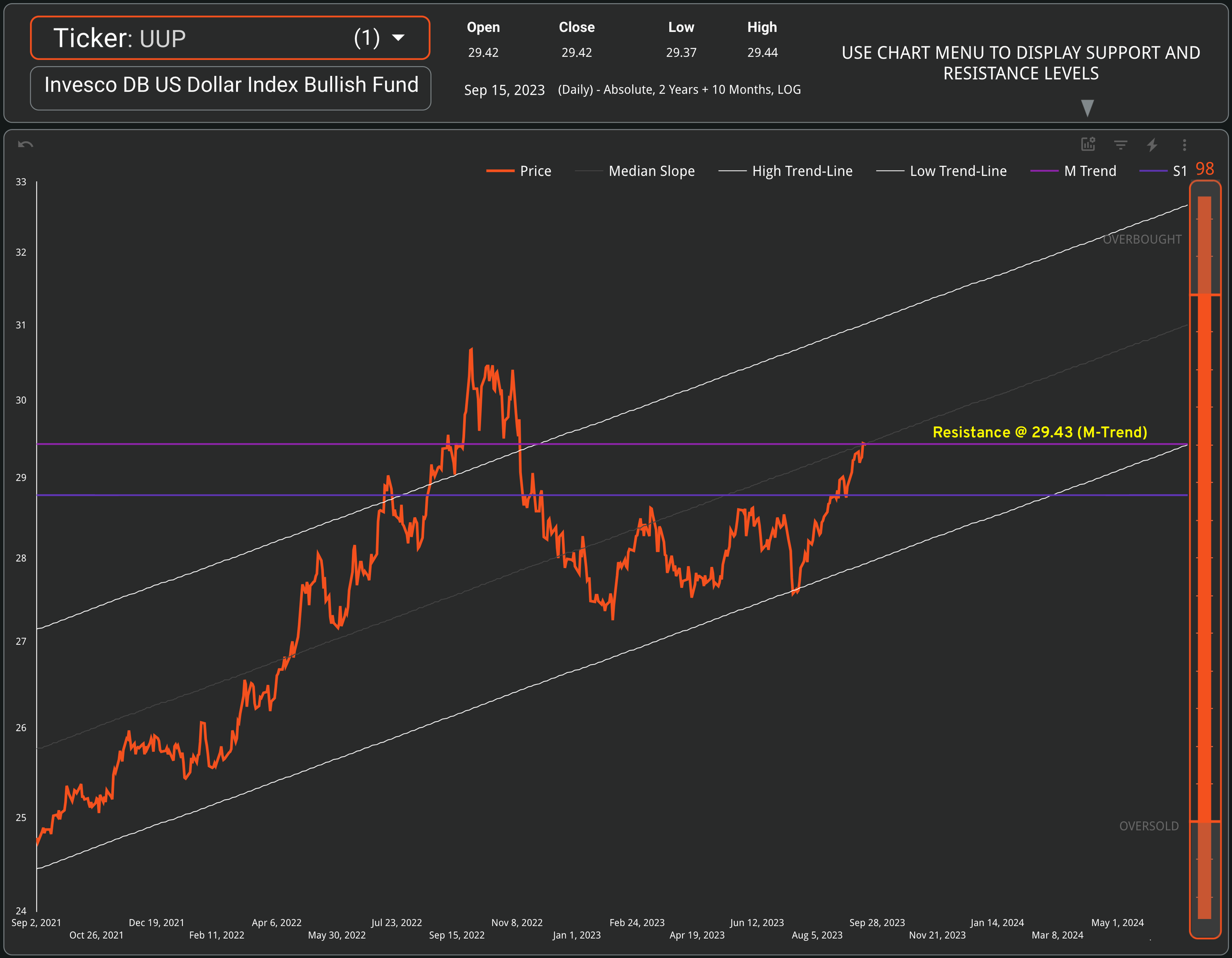/ September 17 / Weekly Preview
-
Monday:
N/A
Tuesday:
Building Permits (1.43M exp. / -1.3% MoM)
Wednesday:
Fed Interest Rate Decision (Hold at 5.5% Expected)
FOMC Economic Projections
Thursday:
Initial Jobless Claims
Friday:
N/A
-
Monday:
N/A
Tuesday:
AutoZone AZO
Wednesday:
FedEx FDX
General Mills GIS
Thursday:
Darden Restaurants DRI
Friday:
N/A
Seasonal weakness continues
The market ended a positive week on a downbeat note. Whatever gains were registered up until Thursday simply evaporated on Friday, as quarterly options and futures expired (nearly $3.2 Trillion in options, to be more precise) . Major indices closed near the lowest levels of the week, with SPY and QQQ trading below their 50-DMA’s by Friday afternoon.
The weakness in equities is not surprising, and serves to confirm September’s negative seasonal bias. Nevertheless, the markets did nothing “wrong” and the Nasdaq even held technical support. The market remains in a neutral (and slightly fearful) disposition, but overall, there is no change to the bullish undertones in the medium term.
SPY Analysis
The MACD Signal remains positive, but only just; a negative crossover will confirm a couple of more weeks of sloppy trading ahead, into early October;
In conclusion, as our models suggest, there is no need to become overly cautious right now. The US Dollar is heavily overbought and hitting against technical resistance. A reversal in the dollar should be supportive for all kinds of risk assets in the following period.
Rising Valuations and the Lag Effect
As calculated at the end of the week in our Market Fundamentals Instrument, P/E ratios have risen sharply at the end of this quarter. Analysts (and by extension, investors) are ramping up projections heading into 2024, and banking on a resumption of growth trends.
However, market participants are bidding up stocks before earnings have throughed. As shown below, courtesy of the same instrument, EPS tends to bottom and recover in about 1.5 - 2 years. In the highlighted periods, when EPS stagnated or declined, the market tended to trade in a volatile manner, with plenty of sharp drawdowns.
This cycle seems to not follow the same pattern, in the sense that the S&P 500 has corrected well ahead of the actual decline in EPS. Similarly, the recovery in stock prices and valuations is also front-running the anticipated rise in EPS. Investors are now more prone to risk, since these earnings could disappoint in 2024 and beyond.
Goldman Sachs noted that valuations across different metrics suggest the market remains historically overvalued. By even the most optimistic measure, forward P/E’s remain in the 80’th percentile.
In the short and medium term, valuations are useless for timing the market. Investor psychology and various supply / demand dynamics tend to dictate these movements instead. But when accounting for longer term performance, valuation starting points do matter a lot. 10-year annualized returns are significantly lower, when starting from higher than average market valuations.
Investors currently believe “this time is different”, as a true economic reversion has not been allowed to occur. The “lag effect” of monetary policy is still working its way through the system. Pandemic era support programs (most notably student loan forgiveness) will soon expire. As all of these sources of extra income wither away, the lag will eventually catch up with the population and expose the economic reality.
When that occurs, a repricing of financial assets will become inevitable. The graph below, courtesy of the San Francisco Fed, shows the effect of excess savings and subsequent drawdowns. Economists note:
“The red area in Figure 1 shows our updated estimate for cumulative drawdowns, which reached more than $1.9 trillion as of June 2023. This implies that there is less than $190 billion of excess savings remaining in the aggregate economy. Should the recent pace of drawdowns persist—for example, at average rates from the past 3, 6, or 12 months—aggregate excess savings would likely be depleted in the third quarter of 2023.”
- Federal Reserve Bank of San Francisco
The issue with interest rates
What are investors hoping to get from exposure to the equity market? The analysis we have performed at the end of Q2 Earnings Season is providing a relevant road-map. Results are displayed on the Dashboard (Market Outlook section), and updated for each day’s close price. Currently, we expect the S&P 500 to return between 1.5% and 8.7% in the year ahead, depending on economic variables.
Meanwhile, the yield on a risk-free 1 year U.S. Treasury bond is 5.43%. That return is guaranteed and carries no drawdown risk whatsoever. As long as interest rates remain elevated, there is an effective cap on the gains that the equity market can make at the index level.
In other words, if the S&P 500 rises by about 3.3% (on no fundamental company news, and just as a function of market dynamics) - the remaining reward to our price target would be equal to the current risk-free rate.
That is a situation where an investor could capture the remaining upside by simply allocating to bonds.
Our Trading Strategy
There are significant risks to the longer term outlook for the equity market, going into 2024 and beyond: tighter financial conditions, slowing wage growth, an economic contraction leading to disappointing earnings are just some examples of valid concerns.
However, we need to trade the market that we have. And that market is currently bullishly biased, suggesting a run to all-time highs is possible in the next couple of months. We need to deal with positions in a granular way, of course, but the overall allocation continues to be fully “risk-on”.
Signal Sigma PRO members will be notified by Trade Alert of any portfolio changes (if subscribed). If you’re not on this plan yet, you can get a free trial when you join our Society Forum.






